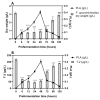Phenyllactic Acid Produced by Geotrichum candidum Reduces Fusarium sporotrichioides and F. langsethiae Growth and T-2 Toxin Concentration
- PMID: 32224845
- PMCID: PMC7232515
- DOI: 10.3390/toxins12040209
Phenyllactic Acid Produced by Geotrichum candidum Reduces Fusarium sporotrichioides and F. langsethiae Growth and T-2 Toxin Concentration
Abstract
Fusariumsporotrichioides and F. langsethiae are present in barley crops. Their toxic metabolites, mainly T-2 toxin, affect the quality and safety of raw material and final products such as beer. Therefore, it is crucial to reduce Fusarium spp. proliferation and T-2 toxin contamination during the brewing process. The addition of Geotrichum candidum has been previously demonstrated to reduce the proliferation of Fusarium spp. and the production of toxic metabolites, but the mechanism of action is still not known. Thus, this study focuses on the elucidation of the interaction mechanism between G.candidum and Fusarium spp. in order to improve this bioprocess. First, over a period of 168 h, the co-culture kinetics showed an almost 90% reduction in T-2 toxin concentration, starting at 24 h. Second, sequential cultures lead to a reduction in Fusarium growth and T-2 toxin concentration. Simultaneously, it was demonstrated that G. candidum produces phenyllactic acid (PLA) at the early stages of growth, which could potentially be responsible for the reduction in Fusarium growth and T-2 toxin concentration. To prove the PLA effect, F. sporotrichioides and F.langsethiae were cultivated in PLA supplemented medium. The expected results were achieved with 0.3 g/L of PLA. These promising results contribute to a better understanding of the bioprocess, allowing its optimization at an up-scaled industrial level.
Keywords: F. langsethiae; F. sporotrichioides; G. candidum; T-2 toxin; biocontrol agent; mycotoxin.; phenyllactic acid.
Conflict of interest statement
The authors declare no conflict of interest.
Figures









References
-
- The Brewers of Europe . European Beer Trends—Statistics Report. The Brewers of Europe; Brussel, Belgium: 2019.
-
- Laitila A. Toxigenic fungi and mycotoxins in the barley-to-beer chain. In: Hill E.A., editor. Food Science, Technology and Nutrition, Brewing Microbiology. Woodhead Publishing; Oxford, UK: 2015. pp. 107–139. (Woodhead Publishing Series).
-
- Kirinčič S., Sˇkrjanc B., Kos N., Kozolc B., Pirnat N., Tavčar-Kalcher G. Mycotoxins in cereals and cereal products in Slovenia—Official control of foods in the years 2008–2012. Food Control. 2015;50:157–165. doi: 10.1016/j.foodcont.2014.08.034. - DOI
Publication types
MeSH terms
Substances
Supplementary concepts
Grants and funding
LinkOut - more resources
Full Text Sources
Miscellaneous

